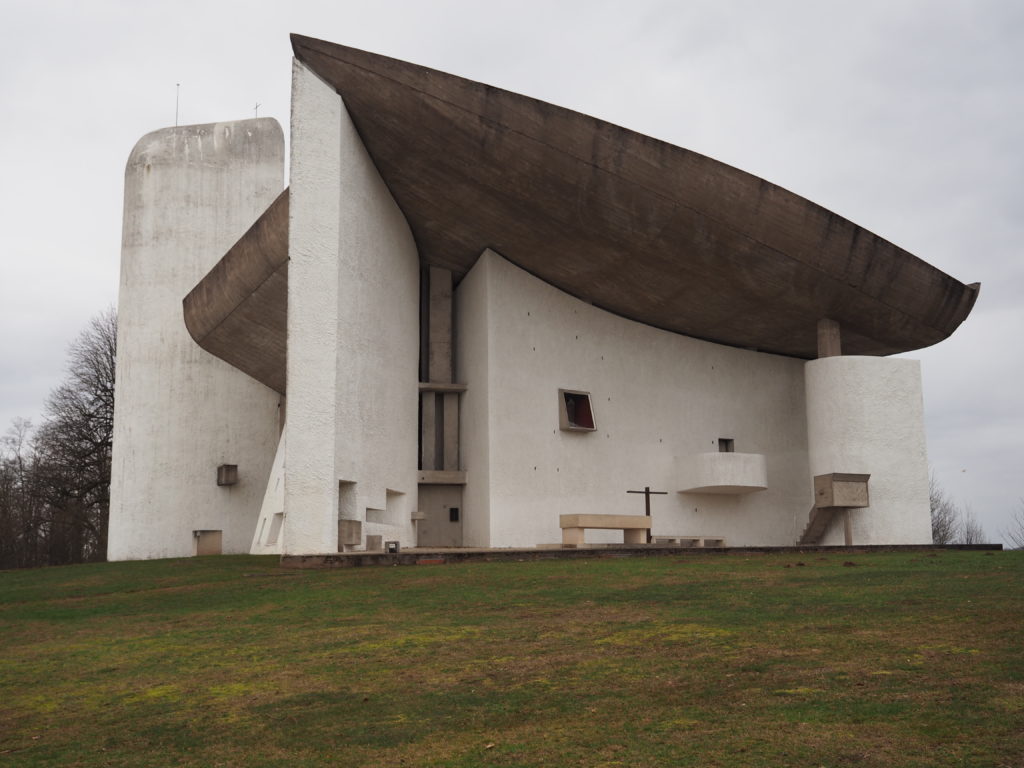High on a hill in a remote area of eastern France sits a solitary pilgrim’s chapel. There has been a chapel here since at least the C4, the last one destroyed by shellfire in the last months of the Second World War. For some reason, not entirely clear, the replacement of this modest building was carried out by, probably, the greatest and most influential architect of the C20 – Le Corbusier. The French Swiss architect, planner, painter and writer was born nearby at the Swiss border town of La Chaux-de-Fonds and had carried out a number of early commissions in the area, but it is still something of a mystery as to why he would accept such a modest commission when at the height of his powers. Perhaps it was the opportunity to create something unique, unfettered by onerous client control, something unlike anything he had done before, something extraordinary and powerful and uplifting … something like Notre dame du Haut. It is said that once he had been persuaded to visit the site, the powerful setting atop the isolated hill was enough to persuade him of the possibilities of something special.
The chapel is visible from miles around, perched high on a hill overlooking the small town of Ronchamp. However, it is only as one approaches closer, the views of the building hidden by the brow of the hill to the last moment, that one sees the extraordinary composition of curving walls and over-sailing concrete roof. The walls, cast in white concrete, are pierced by a myriad of seemingly random openings. The roof is plain, unadorned concrete. Apparently inspired by a crab shell, it nevertheless has echoes of a Breton cap as it soars over the walls, never touching the masonry below but supported on thin steel columns. The thin ribbon of light between roof and walls makes the incredible strength and weight of roof seem to float above the building – one of the truly great feats of modern architecture.
The interior is designed with stunning simplicity, womb like within its curved concrete walls, protecting against the weather and contemplative in its character. Simple details abound, the altar, the pulpit, the benches, but the south wall in contrast is a creation of stunning complexity. The wall, up to 10 feet thick in places, is pierced by a number of precisely scaled and placed openings, some in purpose-designed coloured glass, others clear. The light floods through the angled openings like stage lighting illuminating the interior of a theatre. Apparently, it took Corbusier months to decide on the final design and arrangement of openings. Few other objects in the history of modern architecture have managed to fuse architecture and art in such a cohesive and powerful form.

The building is formed in Le Corbusier’s trademark concrete, but not with his normal angular regularity and rigid geometry. The rational, standardized rigour of his other buildings is abandoned here – this is an organic, flowing building, as though poured from a mould – “plastic happenings” as described by Le Corbusier. Underneath the concrete form is an infill of stone rubble taken from the shattered ruins of the previous chapel, not only a symbolic continuity with the past, but also a practical re-use of materials on a remote and difficult to access site. Indeed, such were the difficulties of access that it is largely hand-built by a small team of builders and craftsmen over the 5 year period 1950-5.
Nearby, Corbusier built a pilgrimage dormitory and priest’s house and more recently Renzo Piano has built a visitor centre and small convent. None of these intrude on the general isolation and appreciation of the chapel, which still stands isolated on the crown of its hill. The chapel was inscribed onto the list of World Heritage sites by UNESCO on July 17, 2016.
Notre Dame du Haut is located by the village of Ronchamp, some 10 miles west of Belfort in Eastern France. It is open every day except 1 January.